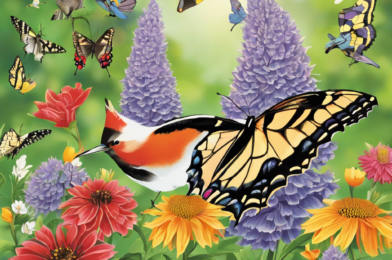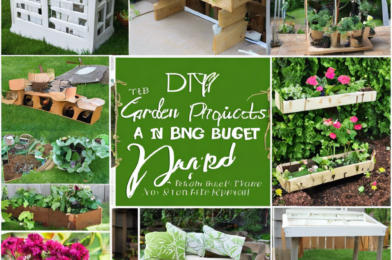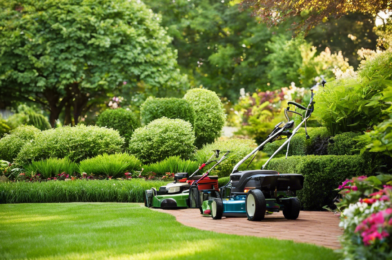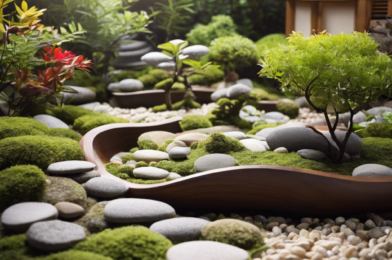Add a splash of color and movement to your garden by attracting butterflies and birds, creating a vibrant and lively space. These beautiful creatures not only add visual appeal but also contribute to a healthy ecosystem. Here are some tips to make your garden a haven for these winged wonders:
First, understand their needs. Butterflies and birds require food, water, shelter, and a place to breed. Provide a variety of nectar-rich flowers that bloom at different times of the year to ensure a constant food source. Place shallow water sources throughout your garden, such as bird baths or small ponds, and create shelter with trees, shrubs, and vines.
When selecting flowers and plants, opt for native species. Native plants are more likely to attract local butterfly and bird species as they are already adapted to the environment. They also tend to be hardier and require less maintenance, making them a more sustainable choice for your garden.
Create a butterfly-friendly space by including host plants, which are specific to each butterfly species and serve as food sources for their larvae. For example, monarch butterflies rely on milkweed plants, while pipevine swallowtails prefer the pipevine plant. By providing these host plants, you directly support the butterfly life cycle and encourage these stunning creatures to make your garden their home.
Birds seek shelter and safety from predators, so consider adding dense shrubs, evergreens, or even birdhouses to your garden. Place birdhouses in quiet, sheltered areas, preferably facing north or east to protect them from direct sun and harsh winds. Birdhouses should be cleaned regularly to prevent diseases, and different bird species have specific requirements, so ensure you cater to their needs.
Butterflies enjoy basking in the sun, so create sun-soaking spots by placing flat rocks in sunny areas. Butterflies also need mud for extracting nutrients, so a wet, muddy spot in your garden will provide them with the minerals they need. By incorporating these simple elements into your garden, you’ll be well on your way to creating a thriving habitat that attracts birds and butterflies alike.
In addition to food and shelter, water is an essential element. Birds need it for drinking and bathing, while butterflies are attracted to shallow, muddy areas where they can extract minerals. Create a small pond or a bird bath, ensuring there are shallow areas for easy access. Keep the water clean and refreshed to avoid the growth of algae and bacteria, which can be harmful. Adding a water feature not only provides for the needs of your feathered and winged visitors but also creates a calming and serene atmosphere in your garden.
Another way to attract birds and butterflies is by creating a diverse habitat with varying heights and levels of vegetation. This can be achieved by planting trees, shrubs, and flowers of different sizes and heights. For example, tall trees provide perching places for birds, while low-growing shrubs and flowers offer shelter and nectar sources for butterflies. A layered landscape offers more opportunities for food, shelter, and breeding, catering to the diverse needs of different species.
Incorporate bright, colorful flowers that produce nectar, as these are particularly attractive to butterflies and hummingbirds. Red, orange, yellow, and pink flowers tend to be attention-grabbing, luring them in for a tasty treat. Opt for tubular-shaped blooms, as their shape is ideal for the long, thin beaks of hummingbirds, and their nectar-rich rewards are perfect for fueling the energetic birds. Be sure to plant these vibrant flowers in clusters, as masses of color are more noticeable to passing pollinators.
To create a dynamic and ever-changing garden that appeals to birds and butterflies, choose plants with different blooming times. This ensures a constant food source throughout the seasons, providing nectar and pollen when other plants may be scarce. Select bulbs, perennials, and shrubs that flower at different times of the year, creating a rotating buffet for your winged visitors. Not only will this make your garden more attractive to wildlife, but it will also add seasonal interest and beauty to your outdoor space.
Maintaining a chemical-free garden is essential for attracting birds and butterflies and ensuring their health and safety. Instead of using pesticides and herbicides, opt for natural alternatives. For example, companion planting can help deter pests, and hand-picking insects is a safe way to control their population. Encouraging beneficial insects, such as ladybugs and lacewings, will also help keep pest populations in check. By embracing natural methods, you create a safe haven for birds and butterflies, free from harmful toxins.
Lastly, be patient and enjoy the process. It takes time for birds and butterflies to discover your garden, and they will return if they find what they need. Sit back, relax, and observe the beauty of nature as it unfolds in your very own sanctuary. Enjoy the sound of birdsong, the flutter of colorful wings, and the knowledge that you’ve created a space that supports and nurtures these wonderful creatures.




